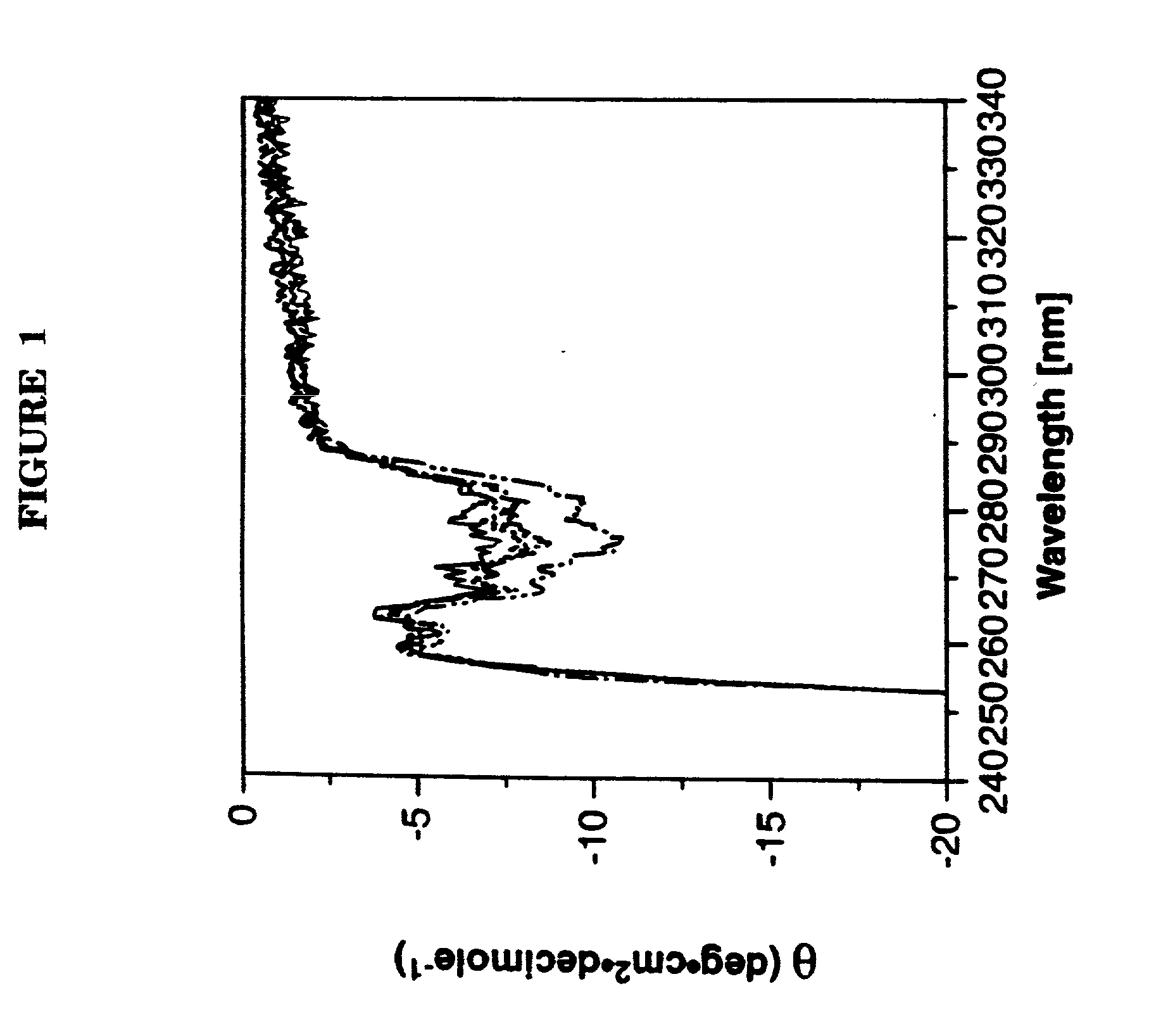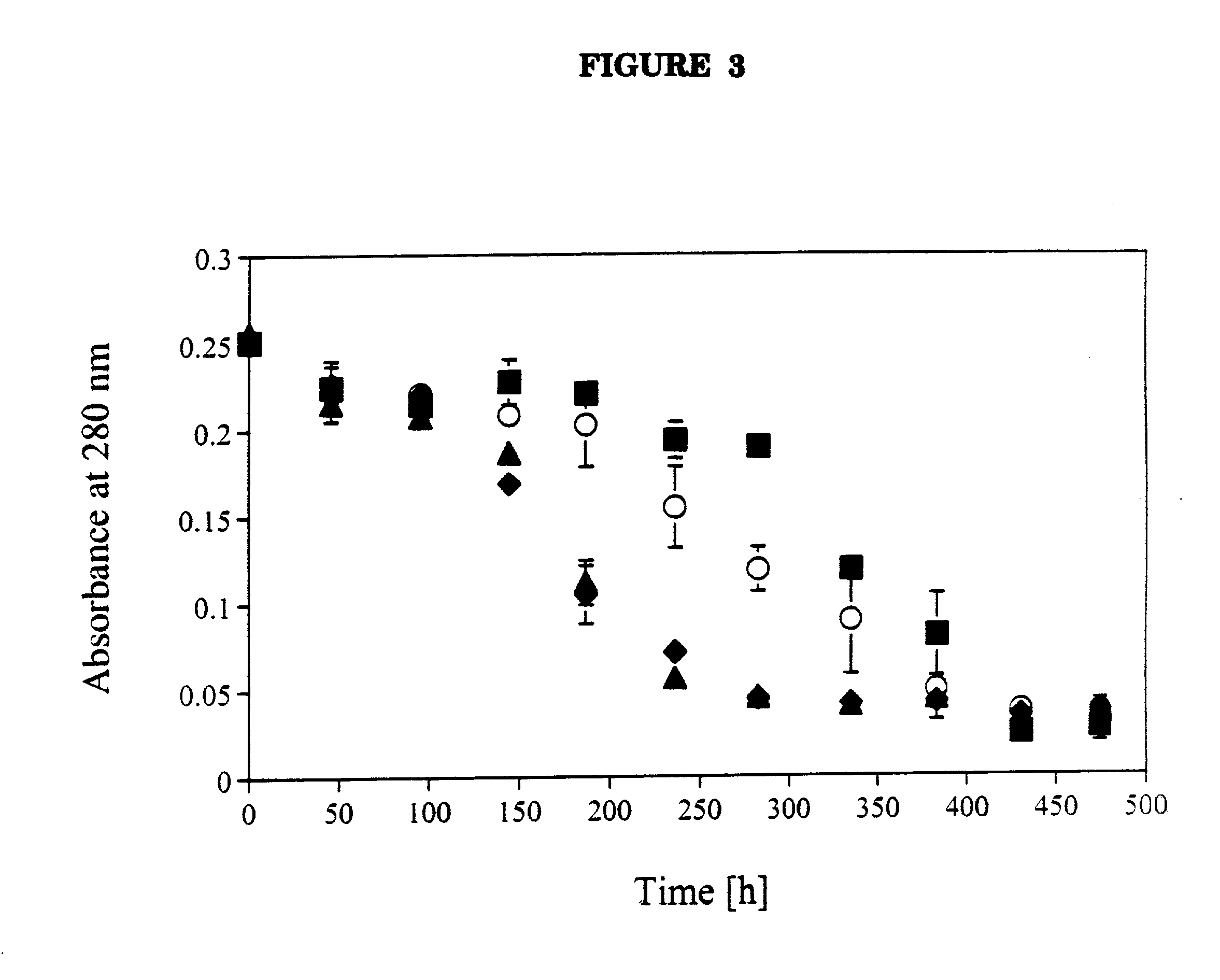Alpha-synuclein super-mutants accelerate alpha-synuclein aggregation
a technology of alpha-synuclein and super-mutants, which is applied in the field of alpha-synuclein super-mutants and acceleration of alpha-synuclein aggregation, can solve the problems of slowing down the pace of such ultilitarian activities, tension which can produce aches and pains in the back, neck, shoulders, temples, etc., and achieves high throughput screening
- Summary
- Abstract
- Description
- Claims
- Application Information
AI Technical Summary
Benefits of technology
Problems solved by technology
Method used
Image
Examples
example 1
[0029] This example describes the cloning and bacterial expression of the wild type .alpha.-synuclein protein and various naturally occurring and artificial .alpha.-synuclein mutant forms.
[0030] A 536 basepair human .alpha.-synuclein cDNA was obtained by PCR amplification from an adult human brain cDNA library using primers corresponding to nucleotides 20-42 and 532-556, respectively, of the published sequence; Ueda et al., Proc. Natl. Aca. Sci. USA, 90:11282-11286 (1993). PCR based site directed mutagenesis of this sequence was then used to generate the mutant forms A53T, A30P, A53T / A30P, E83Q / A90V, H50Y / A53T, and H50T / A53T / A76T. For bacterial expression all forms were amplified using the following primers:
1 TGTGGTCTAGAAGGAGGAATAACATATGGATGTATTCATGAAAG (SEQ ID NO: 5) and GTCTGTCAAAGGCCAAGGAGGGTGTTGTG GGGACCGCGGCTCGAGATTAGGCTTCAGGTTCGTAGTCTTGATA (SEQ ID NO: 6) ACCTTCCTCA
[0031] to alter 3 codons near the 5' end and 1 codon near the 3' end to more highly utilized E. coli codons. The r...
example 2
[0032] This example describes the purification and characterization of the various .alpha.-synuclein forms prepared in Example 1.
[0033] E. coli cell paste was homogenized in 20 mM Tris, 100 mM NaCl, pH 7.5, with protease inhibitor cocktail Complete (Boehringer Mannheim). Cells in suspension were broken by passaging through a Microfluidizer and a clarified lysate supernatant was collected after centrifugation at 18,000.times.g for 45 minutes. E. coli contaminating proteins were then acid precipitated by adjusting the pH of the lysate supernatant to pH 3.5 using 10% (v / v) of acetic acid, stirring for 20-30 minutes, and then centrifuging the mixture for 1 hour at 27,000.times.g. The pH of the resulting supernatant was then adjusted to pH 7.5 using 10% (v / v) of acetic acid, and the sample applied to a Q-Sepharose Fast Flow column (Pharmacia) equilibrated in 20 mM Tris, pH 7.5. The .alpha.-synuclein protein was then eluted from the column using a NaCl gradient from 0 to 300 mM NaCl in 20...
example 3
[0036] This example describes the in vitro aggregation experiments first performed on the wild type .alpha.-synuclein, the naturally occurring A53T mutant, the naturally occurring A30P mutant, and the A30P / A53T mutant forms prepared in Example 2.
[0037] Purified samples of the four forms were concentrated to >7 mg / ml in Tris-buffered saline (20 mM Tris, 200 mM NaCl, pH 7.5)(TBS)+0.05% sodium azide and then sterile filtered through 0.22 micron filters to remove any particulate matter. Each of the filtrates was then adjusted to a final concentration in the range of .about.7 mg / ml in TBS+0.05% sodium azide and incubated over several days at room temperature, 4.degree. C., and 37.degree. C. in parafilm sealed, 1.5 ml ultracentrifuge tubes (Beckman). During the time frame of the experiment, no aggregates formed when incubated at room temperature or at 4.degree. C.
[0038] After incubation for several days at 37.degree. C., all samples began to form insoluble aggregates that could be precipi...
PUM
| Property | Measurement | Unit |
|---|---|---|
| Aggregation | aaaaa | aaaaa |
Abstract
Description
Claims
Application Information
 Login to View More
Login to View More - R&D
- Intellectual Property
- Life Sciences
- Materials
- Tech Scout
- Unparalleled Data Quality
- Higher Quality Content
- 60% Fewer Hallucinations
Browse by: Latest US Patents, China's latest patents, Technical Efficacy Thesaurus, Application Domain, Technology Topic, Popular Technical Reports.
© 2025 PatSnap. All rights reserved.Legal|Privacy policy|Modern Slavery Act Transparency Statement|Sitemap|About US| Contact US: help@patsnap.com



